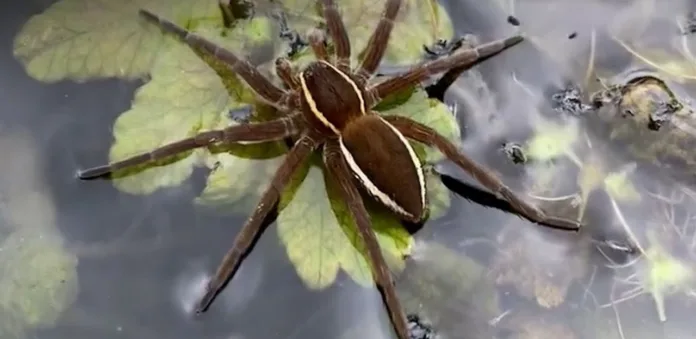Once on the brink of extinction, the fern raft spider population has surged to 10,000 breeding females across the UK, thanks to dedicated conservation efforts.
The rat-sized fern raft spider, once teetering on the brink of extinction in the UK, is making a significant comeback. According to the Royal Society for the Protection of Birds (RSPB), this species, which had dwindled to just three isolated populations by 2010, has seen a resurgence in numbers due to years of dedicated conservation work. Efforts by organizations such as the RSPB and Chester Zoo have been instrumental in increasing the spider population, with an estimated 10,000 breeding females now thriving across the country.
The fern raft spider, known for its large size and ability to catch fish, is one of the UK’s most endangered invertebrates. The spider’s revival is being celebrated by conservationists who have been working tirelessly to protect its natural habitats. The spider’s preferred environment includes wetlands and marshes, where it weaves nurseries above the water surface for its young. These nurseries are the best indicator for spotting the spiders in their natural habitat, as noted by the RSPB.
The remarkable recovery of the fern raft spider population is a testament to the effectiveness of conservation programs aimed at preserving and rehabilitating endangered species. Conservationists hope that this success story will continue to inspire further efforts to protect other at-risk species in the UK.
Analysis:
Political:
The revival of the fern raft spider population is a positive outcome of wildlife conservation policies implemented by the UK government in collaboration with environmental organizations. The success of this initiative may bolster political support for continued and expanded conservation efforts. Moreover, it showcases the government’s commitment to biodiversity, aligning with broader environmental goals, such as those outlined in the UK’s 25 Year Environment Plan. The resurgence of the spider population could potentially influence future policy decisions related to habitat protection and conservation funding.
Social:
The comeback of the fern raft spider reflects society’s growing awareness and appreciation of the importance of preserving biodiversity. Public interest in the conservation of these spiders, driven by media coverage and educational campaigns by organizations like the RSPB, underscores a societal shift towards environmental responsibility. The spider’s revival serves as a reminder of the impact humans can have on the environment, both positive and negative, and highlights the importance of community engagement in conservation efforts.
Racial:
While the direct impact of the fern raft spider’s recovery on racial issues may be limited, the broader implications of conservation efforts emphasize inclusivity in environmental stewardship. The success of conservation programs often depends on engaging diverse communities and ensuring that everyone has access to natural spaces. This inclusivity can foster a collective responsibility for protecting endangered species, promoting unity in the shared goal of preserving biodiversity.
Gender:
In the context of gender, the conservation of the fern raft spider can be linked to the role women play in environmental activism and wildlife protection. Women have been at the forefront of many conservation efforts worldwide, and their involvement in projects like this one highlights the importance of gender equality in environmental leadership. Promoting gender diversity in conservation roles can enhance the effectiveness of such programs by bringing varied perspectives and approaches to the table.
Economical:
Economically, the revival of the fern raft spider population has the potential to contribute to local ecotourism, drawing wildlife enthusiasts to the wetlands and marshes where these spiders are found. The success of conservation programs can also lead to increased funding opportunities from government grants and private donations, which can be reinvested into further environmental projects. Additionally, the preservation of biodiversity is crucial for maintaining ecosystem services that have direct and indirect economic benefits, such as water purification, pollination, and carbon sequestration.
